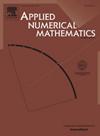A second-order structure-preserving discretization for the Cahn-Hilliard/Allen-Cahn system with cross-kinetic coupling
IF 2.2
2区 数学
Q1 MATHEMATICS, APPLIED
引用次数: 0
Abstract
We study the numerical solution of a Cahn-Hilliard/Allen-Cahn system with strong coupling through state and gradient dependent non-diagonal mobility matrices. A fully discrete approximation scheme in space and time is proposed which preserves the underlying gradient flow structure and leads to dissipation of the free-energy on the discrete level. Existence and uniqueness of the discrete solution is established and relative energy estimates are used to prove optimal convergence rates in space and time under minimal smoothness assumptions. Numerical tests are presented for illustration of the theoretical results and to demonstrate the viability of the proposed methods.
具有交叉动力学耦合的卡恩-希利亚德/艾伦-卡恩系统的二阶结构保留离散化
我们研究了卡恩-希利亚德/艾伦-卡恩系统的数值解法,该系统通过状态和梯度相关的非对角流动矩阵实现强耦合。我们提出了一种在空间和时间上完全离散的近似方案,它保留了基本的梯度流动结构,并导致离散水平上的自由能耗散。建立了离散解的存在性和唯一性,并利用相对能量估计来证明在最小平滑性假设条件下空间和时间的最佳收敛率。为说明理论结果和证明所提方法的可行性,还进行了数值测试。
本文章由计算机程序翻译,如有差异,请以英文原文为准。
求助全文
约1分钟内获得全文
求助全文
来源期刊

Applied Numerical Mathematics
数学-应用数学
CiteScore
5.60
自引率
7.10%
发文量
225
审稿时长
7.2 months
期刊介绍:
The purpose of the journal is to provide a forum for the publication of high quality research and tutorial papers in computational mathematics. In addition to the traditional issues and problems in numerical analysis, the journal also publishes papers describing relevant applications in such fields as physics, fluid dynamics, engineering and other branches of applied science with a computational mathematics component. The journal strives to be flexible in the type of papers it publishes and their format. Equally desirable are:
(i) Full papers, which should be complete and relatively self-contained original contributions with an introduction that can be understood by the broad computational mathematics community. Both rigorous and heuristic styles are acceptable. Of particular interest are papers about new areas of research, in which other than strictly mathematical arguments may be important in establishing a basis for further developments.
(ii) Tutorial review papers, covering some of the important issues in Numerical Mathematics, Scientific Computing and their Applications. The journal will occasionally publish contributions which are larger than the usual format for regular papers.
(iii) Short notes, which present specific new results and techniques in a brief communication.
 求助内容:
求助内容: 应助结果提醒方式:
应助结果提醒方式:


